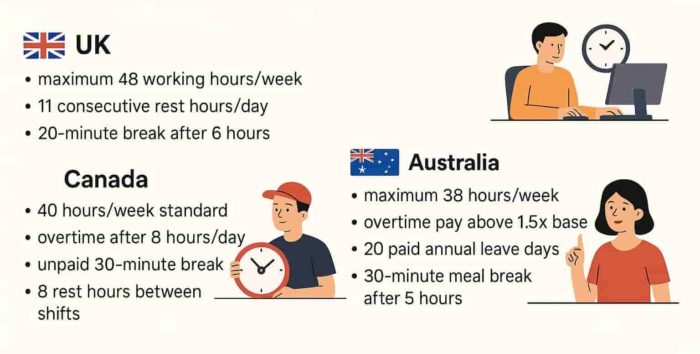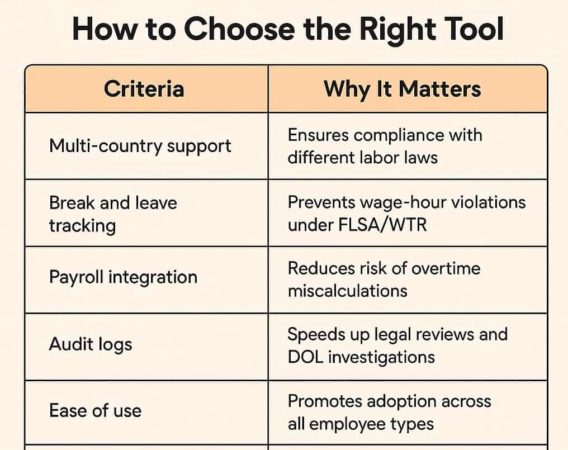As 2025 unfolds, HR leaders overseeing hourly workers across the US, UK, Canada, and Australia are facing unprecedented pressure to modernize their compliance strategies. In the United States, updates to FLSA time tracking and overtime compliance 2025 rules are driving a renewed focus on accurate hour logging, overtime thresholds, and break policies.
For multinational companies and small businesses navigating wage-hour rules, staying compliant isn’t just about avoiding fines—it’s about building trust with employees, ensuring fair pay, and maintaining operational consistency across borders. Yet many teams still rely on outdated manual systems that increase the risk of non-compliance and legal exposure.
This guide breaks down what HR professionals need to know about recent and upcoming changes, and explores how automated solutions like AttendanceBot can help simplify time tracking, overtime compliance, and leave management across multiple regions.
What’s Changing in 2025: Key FLSA Updates HR Leaders Must Know
The U.S. Department of Labor (DOL) has finalized new updates to the Fair Labor Standards Act (FLSA) set to take effect in 2025, which directly impact how companies manage FLSA time tracking, overtime eligibility, and exemption status. These changes come at a time when regulators are doubling down on enforcement, making it essential for compliance teams to stay proactive.
🔹 Higher Salary Threshold for Overtime Exemption
Beginning July 1, 2025, the minimum salary threshold for employees to qualify as exempt under the executive, administrative, and professional exemptions will increase significantly. Employees earning below this new threshold must be classified as non-exempt and are therefore eligible for overtime pay.
- New minimum salary level (2025):
Expected to rise from the current $684/week ($35,568/year) to $1,128/week ($58,656/year).
(Source: DOL Proposed Rule Summary)
🔹 Automatic Future Adjustments
In a shift from prior policy, the DOL plans to implement automatic updates to the threshold every three years, using wage data to adjust for inflation. This means HR systems need to be adaptable—not static—when managing overtime compliance 2025 and beyond.
🔹 Enforcement Priority: Accurate Time Tracking
With these changes, the DOL is increasing scrutiny of how businesses track time—especially for newly reclassified non-exempt employees. Paper timesheets and manual inputs may no longer cut it. Proper FLSA time tracking requires capturing clock-ins, clock-outs, break durations, and all paid/unpaid time with audit-ready accuracy.
📌 Tip: Review your current timekeeping system. Does it automatically calculate overtime, analyse using reports, and sync with payroll? If not, it may be time to explore a tool like AttendanceBot, which integrates with Slack and Microsoft Teams for seamless compliance.
How U.S. FLSA Changes Compare With Labor Laws in the UK, Canada, and Australia
While the 2025 FLSA overtime compliance changes are significant for U.S. operations, regional labor laws in other English-speaking countries remain distinct—and often stricter in areas like maximum work hours, mandatory breaks, and overtime calculations. A cross-border compliance strategy must account for these differences to avoid misalignment.

🇬🇧 United Kingdom: Working Time Regulations
Under the UK’s Working Time Regulations 1998, employees are subject to:
- A maximum average of 48 working hours per week, calculated over a 17-week period, unless the worker opts out.
- 11 consecutive hours of rest in every 24-hour period.
- 20 minutes of break during a shift longer than six hours.
- 28 days of paid annual leave (including public holidays).
Unlike the U.S., UK law enforces daily and weekly rest periods and does not allow unpaid overtime to bypass the 48-hour cap without explicit opt-out agreements.
🇨🇦 Canada: Labour Code (Federal Jurisdiction)
In Canada, the Canada Labour Code, Part III, governs federally regulated workplaces:
- Standard hours: 8 hours/day and 40 hours/week.
- Overtime: Required after 8 hours/day or 40 hours/week, paid at 1.5x the regular rate.
- Rest: Minimum of 8 consecutive hours off between shifts and one full day off per week.
- Breaks: Employees are entitled to an unpaid 30-minute break after 5 hours of work, plus additional paid breaks in some provinces.
Note: Provinces like Ontario and British Columbia may have stricter standards than federal rules.
🇦🇺 Australia: Fair Work Act
Australia’s Fair Work Act 2009 mandates protections under the National Employment Standards (NES):
- Maximum 38 hours/week plus reasonable additional hours.
- Overtime pay and penalty rates vary by award or enterprise agreement but are often above 1.5x base pay.
- 10 minimum paid public holidays and 20 annual leave days per year.
- Breaks and rosters vary by industry award, but many include a 30-minute unpaid meal break after five hours.
Australia’s labor law system relies heavily on Modern Awards, which create detailed, role-specific conditions beyond baseline federal law.
Key Takeaway for HR Teams
Unlike the U.S., where FLSA time tracking compliance primarily focuses on overtime thresholds, other countries emphasize maximum hours, mandatory rest periods, and leave entitlements. A unified global policy should:
- Reflect the strictest standard as a baseline, where possible
- Use automated systems to apply country-specific rules by location
- Document break compliance and opt-outs explicitly
Automating Compliance Across Borders: Top Tools for Time Tracking and Overtime Management
Manual processes are no match for today’s compliance complexity. Between the evolving FLSA 2025 rules in the U.S., the Working Time Regulations in the UK, and statutory standards in Canada and Australia, HR leaders need reliable, scalable software to reduce risk and stay audit-ready.
Here are trusted tools designed to help manage FLSA time tracking, regional labor law compliance, and workforce scheduling—across borders.
AttendanceBot (For Slack & Microsoft Teams)
AttendanceBot is an HR automation tool that works inside Slack and Microsoft Teams, making it ideal for distributed or deskless teams.
Best for: Teams needing seamless integration into existing communication tools.
Key features:
- Rule-based overtime tracking per office location and individual (employee-level)
- Leave and PTO tracking with automatic accruals
- Time capture via chat (e.g., clock in/out, breaks)
- Exportable logs to help identify missed breaks or excessive hours for compliance audits.
- Works well for hybrid or remote organizations
Replicon
Replicon is an enterprise-grade platform that offers advanced time intelligence and compliance management.
Best for: Large multinational organizations with complex compliance layers.
Key features:
- Country-specific labor compliance libraries (FLSA, UK WTR, Fair Work, etc.)
- Real-time tracking of regular vs. overtime hours
- Audit trails and wage-theft prevention features
- Integration with major HCM and payroll systems
Clockify
Clockify is a popular free time tracking app that scales up with paid features like break tracking, leave policies, and overtime reporting.
Best for: Small to mid-sized teams needing basic to moderate compliance features.
Key features:
- Time tracking by project or task
- Overtime calculations
- Time-off request workflows
- Mobile and desktop tracking options
QuickBooks Time (formerly TSheets)
QuickBooks Time is often favored by small businesses in the U.S., Canada, UK, and Australia for its ease of use and payroll integration.
Best for: Businesses already using QuickBooks or Intuit payroll.
Key features:
- Geofencing and mobile time tracking
- Custom overtime rules
- Timesheet approvals and scheduling
- Automatic sync with payroll for FLSA reporting
Deputy
Deputy is a workforce management tool popular in Australia and North America, especially in retail, hospitality, and healthcare.
Best for: Shift-based teams needing scheduling + compliance.
Key features:
- Shift scheduling based on availability and labor law limits
- Compliance triggers for fatigue management
- Easy break planning and timesheet exports
- Built-in compliance with Australia’s Fair Work Award interpretation
How to Choose the Right Tool

💡 Tip: Run a compliance audit now to see where gaps exist in your time tracking or wage-hour process before FLSA enforcement tightens in mid-2025.
Your 5-Step Action Plan for Time Tracking and Overtime Compliance in 2025
Whether you’re aligning with the FLSA 2025 overtime rules in the U.S. or managing entitlements under the UK’s Working Time Regulations, Canada’s Labour Code, or Australia’s Fair Work Act, the goal is the same: protect your company, your people, and your time.
Here’s a simple roadmap to stay ahead.
Step 1: Know the Rules by Region
Bookmark the official labor standards pages for every region you operate in:
- 🇺🇸 FLSA – U.S. Department of Labor
- 🇬🇧 UK Working Time Regulations
- 🇨🇦 Canada Labour Standards
- 🇦🇺 Australia’s Fair Work Act
Step 2: Review Your Current Policies
Audit your existing:
- Clock-in/out procedures
- Break tracking practices
- Overtime thresholds (U.S.: 40 hours/week; UK: 48 hours unless opted out; Australia: modern awards)
- Time-off accrual and carry-over policies
Make sure everything aligns with the latest regional laws.
Step 3: Choose a Tool That Scales With You
Pick a time tracking and compliance tool that fits your org’s structure and locations:
- Small & mid-size hybrid teams → AttendanceBot
- Enterprise/global workforce → Replicon
- Retail/frontline teams → Deputy
- QuickBooks users → QuickBooks Time
- Budget-conscious orgs → Clockify
Step 4: Train Your Managers and Employees
- Create region-specific cheat sheets for hours, breaks, and overtime
- Schedule refreshers on clocking in/out accurately
- Remind teams of consequences for non-compliance (including fines or backpay claims)
Step 5: Run Quarterly Compliance Checks
- Export timesheets for audit review
- Check for red flags like unlogged breaks or excessive OT
- Stay on top of legal updates (e.g., via DOL’s email alerts)
TL;DR — Compliance Can’t Wait
Staying ahead of evolving overtime rules and labor regulations across multiple regions is key to mitigating risk and maintaining operational efficiency. With the right tools, regular policy audits, and ongoing employee training, HR leaders can ensure compliance while keeping their workforce engaged and productive across borders.



